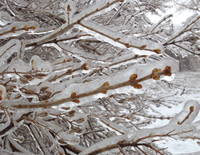Stay tuned for upcoming releases of phenology data products and tools this spring! We have many products and upgrades in the works, including gridded models, a a fresh update to our existing data output tool, and site-level in-situ summarized data.
I'm also excited to share with you some funding opportunities well suited for phenology proposals from NSF Macrosystems and LTER, and a chance to share valuable information about your herbarium phenology research. Don't forget to submit your ESA abstract by February 25th, as we will be convening a special session for phenology data users.
Remember, you can always catch up by checking out past newsletters. Don't hesitate to contact me if you would like to get involved in the development or testing of national-scale phenology data products!
|
|
What's new at the USA National Phenology Network
|
|

Phenology model development
In March the USA-NPN will bring together phenology modelers who use in-situ NPDb data in their research to coordinate and collaborate on ways to create improved predictive continental-scale data products. Activities will include identifying gaps in knowledge, determining what models and data are needed, and evaluating approaches to validate models.
Stay tuned for outcomes related to this workshop as well as opportunities to get involved in future related activities!
|

Do you study phenology using herbarium specimens?
A group of researchers funded by iDigBio are conducting a survey to learn more about how scientists score phenology on herbarium specimens in order to create a set of data standards that can be used to integrate results across studies.
Please take a survey so these researchers can learn more about what phenological metrics you use, want to use, score, or otherwise think are important. The survey should take you 10 minutes. Please respond by February 15th, 2016.
|

Coming soon: Gridded phenology products
Stayed tuned for dynamic gridded Si-x and growing degree day (GDD) maps and documentation! We anticipate that these will be available by April 2016 as layers in the visualization tool as well as be accessible through a geoserver application.
|

Coming soon: Site-level phenometric data
We are close to releasing dynamic site-level summarized data through a fresh upgrade to our data output tool! This dataset will provide mean annual phenophase onset and end dates and will enable in-situ data to be easily integrated with remotely sensed data and climate data.
|
|

Special Issue on Citizen Science and Earth Observation
|

NSF Macrosystems call for proposals
Did you know that the in-situ data phenology collected by NEON uses the same protocols as USA-NPN? Check out the NSF Macrosystems call for proposals that use early NEON data if you analyze phenology data from multiple scales or carry out research that integrates phenology datasets. Proposals are due March 15th and October 17th.
|

Land Surface Phenology Graduate Position
It is expected that the student have strong quantitative and communication skills, programming experience (e.g. R, Python, MATLAB), and an understanding of terrestrial remote sensing fundamentals.
|

Science to Action Fellowship
|

-
Ecological Society of America. Fort Lauderdale, Florida. August 7-12, 2016. At this meeting there will be a special evening session dedicated to phenology to learn more about data products and resources and to discuss the future of the field!
|

Plants with late phenology are more sensitive to frost
A recent study in the Journal of Ecology by Caradonna and Bain examined frost sensitivity in four congeneric pairs of alpine plants. They found that flowers were more sensitive to frost than leaves, and that species with later phenologies were more sensitive than those with early phenologies. These results suggest a widespread trade-off between frost sensitivity and phenology.
|

Bird wing length associated with the timing of spring green-up
According to a new study published in Ecology and Evolution, Hahn et al. found that wing length was associated with the phenology at breeding destinations for a long-distant migrant, the common nightingale. The results of this study suggest that longer wings help adjust migration speed in habitats with fast spring green-up and short optimal arrival periods.
|
|
|
|